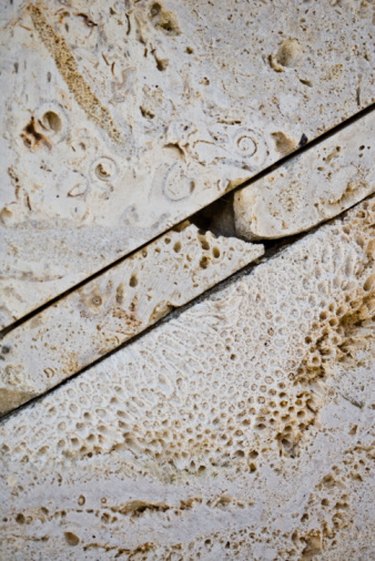
Acid rain is a byproduct of both natural and man-made conditions. In the atmosphere, rain mixes with carbon dioxide, nitrous oxide and sulfuric dioxide to form acid rain. These constituents may occur naturally from processes such as volcanic eruptions and the oxidation of rocks, or their presence in the atmosphere may be due to pollutant releases from manufacturing facilities. Acid rain has a direct effect on limestone rocks that occur in soil, below ground and on buildings.
Chemical Reaction
Video of the Day
Three common acids that form in the atmosphere are carbonic acid that forms from carbon dioxide, nitric acid that forms from nitrous oxide and sulfuric acid that forms from sulfur dioxide. Acid rain may form with water as a liquid, or as dry and gaseous forms of the acids that settle to the earth. Limestone rock is composed of mostly calcite, which is a calcium carbonate mineral. The calcium carbonate reacts with the acid rain and dissolves into solution. Limestone components may also react with the acid rain to form gypsum mineral crystals.
Video of the Day
Surficial Limestone Effects
As acid rain falls to the earth's surface, limestone rocks and limestone components in soil will react with the rain, neutralize the acid and dissolve. As the limestone dissolves, the rocks will wear away, becoming pitted with rounded edges. The dissolution process will change the appearance of the landscape as the rocks slowly wear away over time. Limestone particles in soil will dissolve into rainwater and leach the calcium from the topsoil, which reduces its availability for plant life.
Underground Limestone Effects
Acid rain that seeps into the subsurface through soil penetration or stream loss can dissolve underground limestone rocks. As acidic water encounters limestone, it infiltrates cracks in the rock and begins to erode the rock below ground. Over time, the limestone may dissolve to the point where it creates sinkholes on the land surface or underground caves.
Limestone Construction Effects
One of the most noticeable effects of acid rain is on limestone blocks that are part of a building or statue. Over time, the acid rain will round the edges of statues and pit the flat surfaces of the rock. Another common reaction is the production of gypsum on the surface of the limestone that comes in contact with sulfuric acid. Gypsum is soluble in water and often does not cling to the surface of a limestone rock; however, on buildings or statues that are partially sheltered, the gypsum may precipitate and form a crust on the rock. As the crust ages, it traps dirt which turns the white mineral a dark color. The gypsum will eventually peel away from the partially dissolved limestone.
- Elmhurst College; Acid Rain: Soil Interactions; Charles E. Ophardt; 2003
- USGS; How Does Acid Precipitation Affect Marble and Limestone Buildings?; John Watson; 1997
- EPA; What is Acid Rain?; 2007
- University of Wisconsin at Eau Claire; Cave Formation; Abbey Graves et al.
- SUNY at Plattsburgh Center for Earth & Environmental Sciences; Effects of Acid Rain; Tom Wolosz